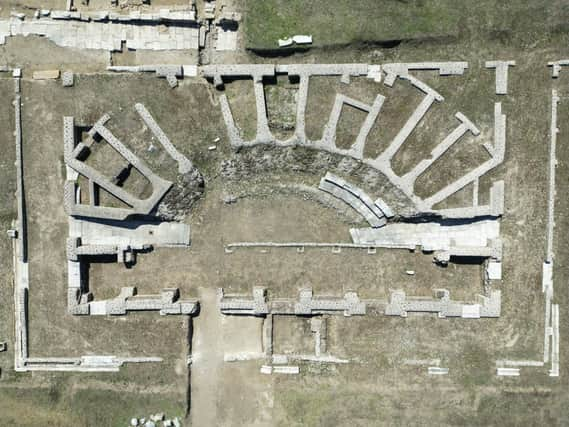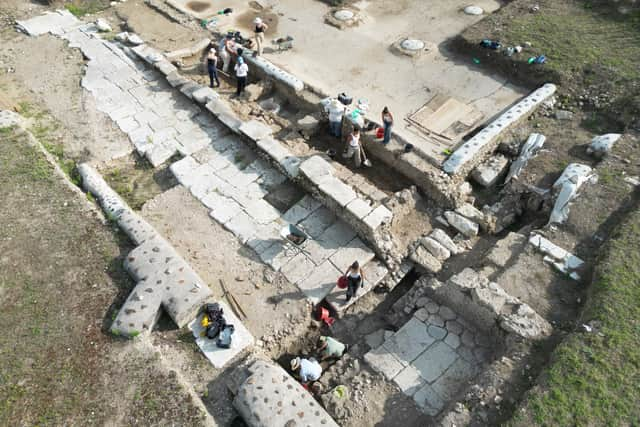Cambridge University study reveals Italian town bucked decline of Roman Empire


New evidence have revealed how a 'backwater' Italian town bucked the decline of the mighty Roman Empire by as much as 300 years. Interamna Lirenas in central Italy continued to "thrive" well into the 3rd Century AD, during what is normally considered as a period when the once-dominant Roman society collapsed.
A rare roofed theatre, markets, warehouses, a river port and other startling discoveries were made during a 13-year study by a Cambridge University-led team of archaeologists. They say their findings, published in Roman Urbanism in Italy, change our understanding of the Empire's history. The team’s pottery analysis indicates that the town’s decline began around 300 years later than previously assumed.
Advertisement
Hide AdAdvertisement
Hide AdAnd a systematic geophysical survey has produced an astonishingly detailed image of the entire town’s layout, highlighting a range of "impressive" urban features. Study author Dr Alessandro Launaro said: “We started with a site so unpromising that no one had ever tried to excavate it – that’s very rare in Italy. There was nothing on the surface, no visible evidence of buildings, just bits of broken pottery.
"But what we discovered wasn’t a backwater, far from it. We found a thriving town adapting to every challenge thrown at it for 900 years. We’re not saying that this town was special, it’s far more exciting than that. We think many other average Roman towns in Italy were just as resilient. It’s just that archaeologists have only recently begun to apply the right techniques and approaches to see this.”


Because the site was mostly open fields, the archaeologists were able to conduct a magnetic and ground-penetrating radar (GPR) survey of around 60 acres.
Dr Launaro and his colleagues mapped the town’s development using a far larger and more reliable body of excavated evidence, tens of thousands of pieces of common ware pottery. It showed that the town actually resisted decline until the later part of the 3rd century AD, around 300 years later than previously assumed.
Advertisement
Hide AdAdvertisement
Hide AdAt its peak, Dr Launaro believes the town would have housed around 2,000 people. He said: “Based on the relative lack of imported pottery, archaeologists have assumed that Interamna Lirenas was a declining backwater. We now know that wasn’t the case.”
The team’s re-appraisal of an inscription found in the 19th Century confirms that Interamna Lirenas gained the patronage of Julius Caesar in 46 BC. But Dr Launaro argues that didn't make it exceptional or explain the town’s long-term success. Instead, the archaeologists’ findings help to explain why the town would have appealed to Caesar.
Dr Launaro, a Fellow of Gonville & Caius College, said: “Interamna Lirenas was strategically located between a river and a major road, and it was a thriving node in the regional urban network. It would have been valuable to Julius Caesar as he sought to consolidate support across Italy during the civil wars. This town continually played its cards right, it was always forging relations with communities between Rome and southern Italy while thriving as a trading hub.”
The team’s GPR survey near the River Liri revealed the presence of a large warehouse, a temple and a bath complex. They are confident that the structures all served a river port between the late 1st Century BC and the 4th Century AD.
Advertisement
Hide AdAdvertisement
Hide AdDr Launaro said: “River ports didn’t just need warehouses. People spent a lot of time working and resting in the vicinity so they needed all kinds of amenities, just like the ones we found here.”
He said The River Liri was undoubtedly navigable because the Emperor Claudius planned to make it even more so by diverting the waters of a lake into it. Dr Launaro added: “This river port enabled Interamna Lirenas to profit from trade between Aquinum and Casinum, key centres to the north, and Minturnae and the Tyrrhenian coast to the south-east. It would have been crucial to the town’s success.”
Along the northwestern side of the town, the archaeologists discovered the remains of a roofed theatre which would have towered over an open terrace. The theatre would have been big enough to seat 1,500 people. Dr Launaro said roofed theatres are relatively rare in Roman Italy and represent a "significant upgrade" on open-air structures, acoustically, architecturally and financially. The theatre boasted diverse marbles imported from across the Mediterranean.
Dr Launaro added: “The fact that this town went for a roofed theatre, such a refined building, does not fit with a backwater in decline. This theatre was a major status symbol. It displayed the town’s wealth, power and ambition.
Advertisement
Hide AdAdvertisement
Hide Ad“The assumed lack of a theatre here was taken as evidence of the town’s decline. At nearby Roman towns, archaeologists saw the remains of theatres sticking out of the ground. The remains of Interamna Lirenas’ amazing theatre was there all along, just completely buried.”
The archaeologists did not find a layer of ash or any other evidence to suggest that the town was violently destroyed. Dr Launaro believes that the inhabitants probably deserted the town amid growing insecurity but before the Lombard invasion of the late 6th Century AD, because they knew they were on a direct route which marauding armies were bound to use.
He said today's residents of Pignataro Interamna, the nearest town to the site, have taken Interamna Lirenas’ revised history to heart.
Dr Launaro added: “This community has been inspired by this story of reinvention and resilience. They’ve even renamed the local café after the Sundial we discovered.”
Comment Guidelines
National World encourages reader discussion on our stories. User feedback, insights and back-and-forth exchanges add a rich layer of context to reporting. Please review our Community Guidelines before commenting.